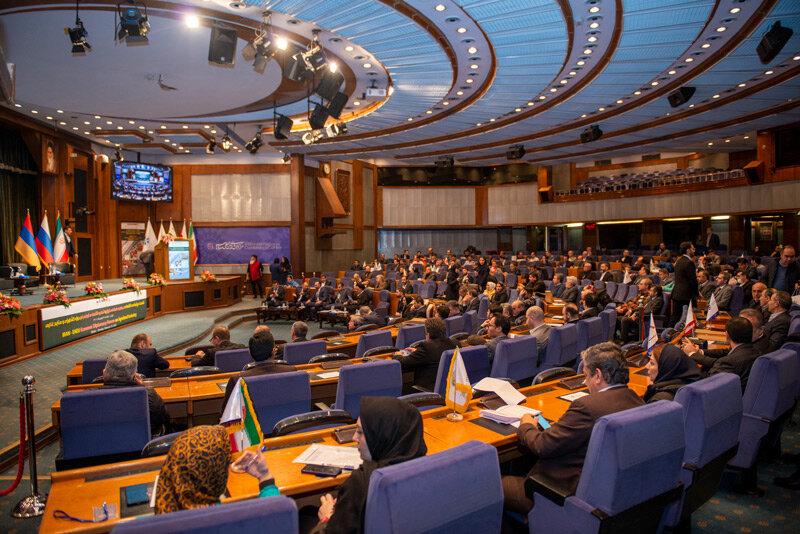TCCIMA holds conference on Iran-EAEU trade opportunities
TCCIMA holds conference on Iran-EAEU trade opportunities
Tehran Chamber of Commerce, Industries, Mines and Agriculture (TCCIMA) hosted a conference on the trade opportunities of Iran and the Eurasian Economic Union (EAEU) on Monday during which trade-related issues in areas like agriculture and foodstuff were discussed, the TCCIMA portal reported.

The conference was attended by private sector representatives along with TCCIMA officials including TCCIMA Head Masoud Khansari, and Head of TCCIMA Agriculture Committee Kaveh Zargaran; Eurasian Economic Commission (EEC) Minister in charge of Integration and Macroeconomics Sergei Glazyev also attended the meeting through an online video message.
Free trade with Eurasia, an opportunity to neutralize sanctions
Speaking at the opening ceremony of the conference, Khansari underlined Eurasia’s special geopolitical position, saying that the Eurasian region has its own unique characteristics and is considered the connecting point between Asia and Europe.
“Iran's trade with the Eurasian Economic Union was more than five billion dollars in 2022, which has grown significantly, and we hope that this trend will continue in the future,” the TCCIMA head added.
The official stressed that free trade with the Eurasian Economic Union has created an opportunity to neutralize Western sanctions.
“Creating unified regulations in transportation, money transfer, and quarantine standards are some of the items that the Iranian private sector is seeking from its membership in this union,” he said.
Lack of transportation, banking infrastructures, a major challenge to trade
Elsewhere in the event, Zargaran addressed the conference and spoke about the requirements for the development of trade with the Eurasian Economic Union.
“Over the past years, although effective measures have been taken to improve the level of economic relations with the five member countries of the Eurasian Union, Iran's trade with these five countries has been mainly focused on Russia and then Kazakhstan,” he regrated.
Zargaran further pointed to the infrastructure problems that hinder the further increase of commercial cooperation between the two sides, and continued: “The transportation infrastructure, especially in the Caspian Sea, faces many shortcomings; The result is that despite the production of about 150 million tons of cereal in Russia and the import of about 17-18 million tons of such products by Iran, the volume of cereal trade between Iran and Russia is less than three million tons.”
The official also underlined the lack of a direct channel for financial transfers as another major obstacle in the way of the development of relations between Iran and Russia and said: “Now that Russia has joined the club of sanctioned countries, establishing a direct banking line between Iran and Russia will be very effective in developing economic relations. In other words, establishing a simple financial transaction between two countries and then extending it to other member countries of the Eurasian Union is one of the demands of the Iranian private sector.”
Consequences of sanctions for global food security
In the final part of the opening ceremony, Sergei Glazyev also made a speech about the consequences of sanctions for the global food supply-chain.
“The embargo imposed by the United States and the European Union on food suppliers not only creates problems for the sanctioned countries but also causes hunger and malnutrition for millions of people in other parts of the world,” Glazyev said in his video message.
After years of negotiations, Iran and the EAEU finalized a free trade agreement (FTA) in late January, announcing that the FTA is going to be put in effect by mid-Iranian calendar year 1402 (late September this year).
This FTA is expected to have a significant positive effect on the volume of trade between the two sides.
Iran and EAEU had reached a preferential trade agreement in 2018 based on which about 862 commodity items are currently subject to preferential tariffs. The agreement came into effect on October 27, 2019.
The value of trade between Iran and the EAEU members reached $5.643 billion during the previous Iranian calendar year 1400 (ended on March 20, 2022), registering a 66-percent rise compared to the figure for the preceding year.
Head of Iran’s Trade Promotion Organization (TPO) has said the long-awaited free trade agreement (FTA) between the Islamic Republic and the Eurasian Economic Union (EAEU) is going to be put in effect by mid-Iranian calendar year 1402 (late September).
Alireza Peyman-Pak made the remarks after a meeting with Minister in charge of Trade of the Eurasian Economic Commission Andrey Slepnev in Tehran on January 19.
“In the last two and a half years, more than 30 rounds of negotiations have been held with the representatives of five member countries of the Eurasian Union, and thank God, we reached a final agreement in this round,” the TPO head said.
According to Peyman-Pak, during the Thursday meeting, the two sides concluded their negotiations and the draft of the agreement was finalized.
The official noted that the list of the commodities to be included in the FTA has been also finalized, saying: “The two sides made the final talks today, according to which 90 percent of the items were put on the green trade list with the rest 10 percent enlisted as forbidden items.”
He noted that the FTA will have a significant positive effect on the volume of trade between the two sides.
In the meantime, the EAEU trade minister said that the five members of this union attach special significance to cooperation with Iran.
Slepnev said that Iran is a close ally of Russia and other EAEU member countries. He also believed that the preferential trade agreement between the two sides led to an expansion of economic cooperation with Iran.

Write your comment.